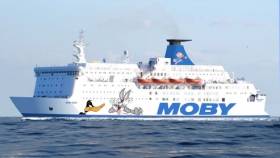Displaying items by tag: UEFA EURO 2016
#FerrytoMed – Former Cork-Swansea ferry Julia of the Fastnet Line that closed in 2011, is to enter service in July on a Mediterranean service between France and Corsica, writes Jehan Ashmore.
As previously reported on Afloat.ie, the Julia (1982/22,161gt) which operated the Ireland-Wales link for only two seasons was re-sold to Italian operator Moby Lines, and is to enter a new Nice-Bastia (Corsica) service. This follows an interim career for Dutch owners as the Wind Perfection that provided floating accommodation in the Irish Sea for workers during construction of a wind-farm.
Under her new owners as Moby Zazà, the 1,850 passenger/325 car/30 truck ferry underwent a drydocking in Liverno to include the company’s customary ‘cartoon’ livery depicting Warner Bros. Looney Tunes characters. She will enter the Nice-Bastia service next month, though the new route was only launched at the beginning of this month.
Commenting to Afloat, a spokesperson for Moby Lines said that in the meantime the route is currently served by Moby Corse (1978/14,399gt). In recent days due to the football matches of Euro 2016 held at the Allianz Arena Nice, Moby Lines have informed customers to expect increased traffic and congestion in the city.
The launch of the Nice-Bastia service which is to be operated year round is in direct competition with established operator, Corsica-Sardinia Ferries. Likewise of the new entrant they have a ferry network that includes routes to and from the France and also the Italian mainland.
Sailings times connecting the Cote D’Azur and the north-eastern Corsican port are scheduled for 7 hours 30 minutes during the day while overnight crossings will take 9 hours. Moby Zasa was launched as Olau Britannia to serve a first career sailing between Sheerness, UK and Vlissengen, Netherlands along with Olau Hollandia.
In regards to Moby Corse (as alluded above) this ferry also originally began a career sailing in the North Sea as the Dana Anglia. She served DFDS Seaways service linking England and Denmark and notably the ferry was used as the setting for a 1980’s soap opera TV series ‘Triangle’.
In much more recent times she sailed for Brittany Ferries as Pont-l'Abbé on the Plymouth-Roscoff run. Like numerous northern based European ferries, the final years of these veteran ships are mostly to be seen plying the Mediterranean.























